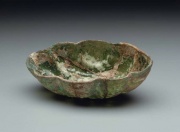Green glass
Description
Pale green to olive green tones can occur naturally in glass due to the presence of Iron impurities. Additions of chromium compounds have been used to make a bright emerald green color glasses while cupric oxide produces a clear blue-green. In the 19th century, the term 'green glass' was used to refer to inexpensive bottle glass formed from inferior materials such as coarse sea or river sand, lime, and clay and inferior alkalis obtained from soapboilers waste and iron slag (Schur 1985). To minimize unwanted green casts, Sodium nitrate or Manganese dioxide were added to the glass mixture.
Synonyms and Related Terms
verre à bouteille (Fr.); vidrio verde (Esp.); groen glas (Ned.); vidro verde (Port.)
Additional Information
S. Schur, "Conservation Terminology: A Review of Past & Current Nomenclature of Materials", Technology and Conservation, 1985.
Sources Checked for Data in Record
- Encyclopedia Britannica, http://www.britannica.com Comment: "glassware" Encyclopædia Britannica from Encyclopædia Britannica Premium Service. [Accessed May 5, 2004].
- The Dictionary of Art, Grove's Dictionaries Inc., New York, 1996 Comment: "Glass"
- Susan E. Schur, Conservation Terminology: A review of Past & Current Nomenclature of Materials, Technology and Conservation, Spring (p.34-39); Summer (p.35-38); Fall (p.25-36), 1985
- Thomas Gregory, The Condensed Chemical Dictionary, Reinhold Publishing, New York, 3rd ed., 1942
